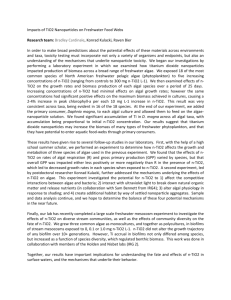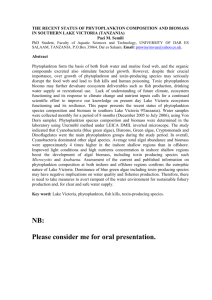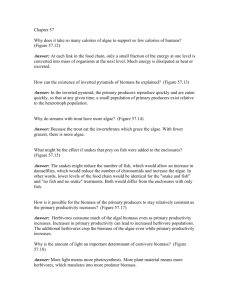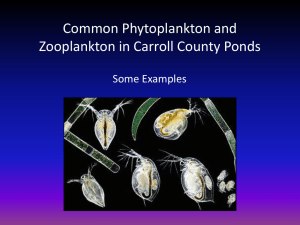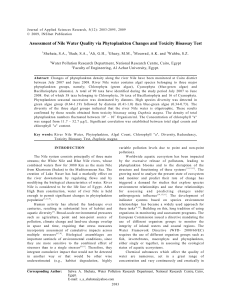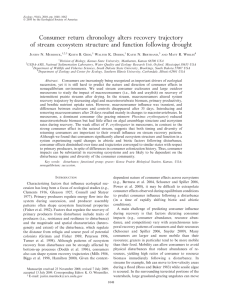PEG Summary
advertisement
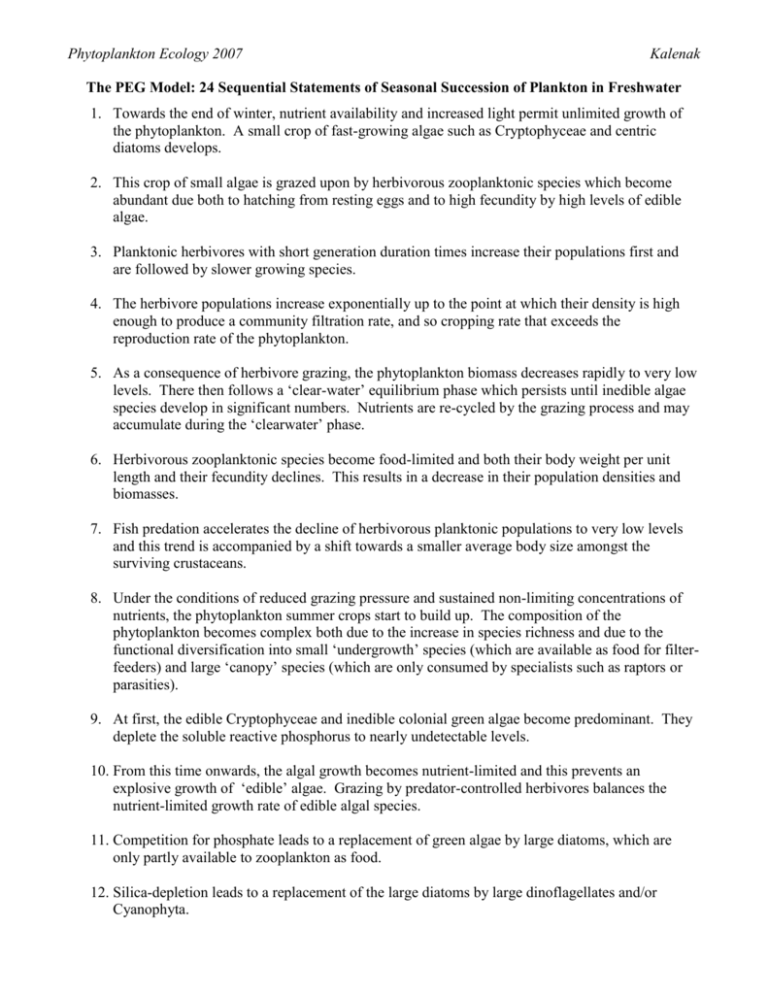
Phytoplankton Ecology 2007 Kalenak The PEG Model: 24 Sequential Statements of Seasonal Succession of Plankton in Freshwater 1. Towards the end of winter, nutrient availability and increased light permit unlimited growth of the phytoplankton. A small crop of fast-growing algae such as Cryptophyceae and centric diatoms develops. 2. This crop of small algae is grazed upon by herbivorous zooplanktonic species which become abundant due both to hatching from resting eggs and to high fecundity by high levels of edible algae. 3. Planktonic herbivores with short generation duration times increase their populations first and are followed by slower growing species. 4. The herbivore populations increase exponentially up to the point at which their density is high enough to produce a community filtration rate, and so cropping rate that exceeds the reproduction rate of the phytoplankton. 5. As a consequence of herbivore grazing, the phytoplankton biomass decreases rapidly to very low levels. There then follows a ‘clear-water’ equilibrium phase which persists until inedible algae species develop in significant numbers. Nutrients are re-cycled by the grazing process and may accumulate during the ‘clearwater’ phase. 6. Herbivorous zooplanktonic species become food-limited and both their body weight per unit length and their fecundity declines. This results in a decrease in their population densities and biomasses. 7. Fish predation accelerates the decline of herbivorous planktonic populations to very low levels and this trend is accompanied by a shift towards a smaller average body size amongst the surviving crustaceans. 8. Under the conditions of reduced grazing pressure and sustained non-limiting concentrations of nutrients, the phytoplankton summer crops start to build up. The composition of the phytoplankton becomes complex both due to the increase in species richness and due to the functional diversification into small ‘undergrowth’ species (which are available as food for filterfeeders) and large ‘canopy’ species (which are only consumed by specialists such as raptors or parasities). 9. At first, the edible Cryptophyceae and inedible colonial green algae become predominant. They deplete the soluble reactive phosphorus to nearly undetectable levels. 10. From this time onwards, the algal growth becomes nutrient-limited and this prevents an explosive growth of ‘edible’ algae. Grazing by predator-controlled herbivores balances the nutrient-limited growth rate of edible algal species. 11. Competition for phosphate leads to a replacement of green algae by large diatoms, which are only partly available to zooplankton as food. 12. Silica-depletion leads to a replacement of the large diatoms by large dinoflagellates and/or Cyanophyta. Phytoplankton Ecology 2007 Kalenak 13. Nitrogen depletion favors a shift to nitrogen-fixing species of filamentous blue-green algae. 14. Larger species of crustacean herbivores are replaced by smaller species and by rotifers. These small species are less vulnerable to fish predation and are less affected by interference with their food collecting apparatus which can be caused by some forms of inedible algae. Accordingly, their population mortality is lower and their fecundity is higher than that of the larger species. 15. The smaller species of herbivores coexist under a persistent fish predation pressure and the increased possibility of food partitioning which is associated with the greater species complexity of the phytoplankton. 16. The population densities and species composition of the zooplankton fluctuate throughout the summer, the latter being also influenced by temperature. 17. The period of autogenic succession is terminated by factors related to physical changes which includes increased mixing depth resulting in nutrient replenishment and a deterioration of the effective underwater light climate. 18. After a minor reduction in algal biomass, an algal community develops which is adapted to being mixed. Large unicellular or filamentous algal forms appear. Among them diatoms become increasingly important with the progress of autumn. 19. This association of poorly-ingestible algae is accompanied by a variable biomass of small, edible algae. 20. This algal composition together with some reduction in fish predation pressure leads to an autumnal maximum of zooplankton which includes larger forms and species. 21. A reduction of light energy input results in a low or negative net primary production and an imbalance with the algal losses which causes a decline of algal biomass to the winter minimum. 22. Herbivore biomass decreases as a result of reduced fecundity due both to lower food concentrations and to decreasing temperature. 23. Some species in the zooplankton produce resting stages at this time, whereas other species produced resting stages earlier. 24. At this period in the year, some cyclopoid species ‘awake’ from their diapause and contribute to the over-wintering populations in the zooplankton. Source: Sommer, U., ZM. Gliwicz, W. Lampert, A. Duncan. 1986. PEG-model of Seasonal Succession of Planktonic Events in Fresh Waters. Archives of Hydrobiology. 106(4): 433471.


